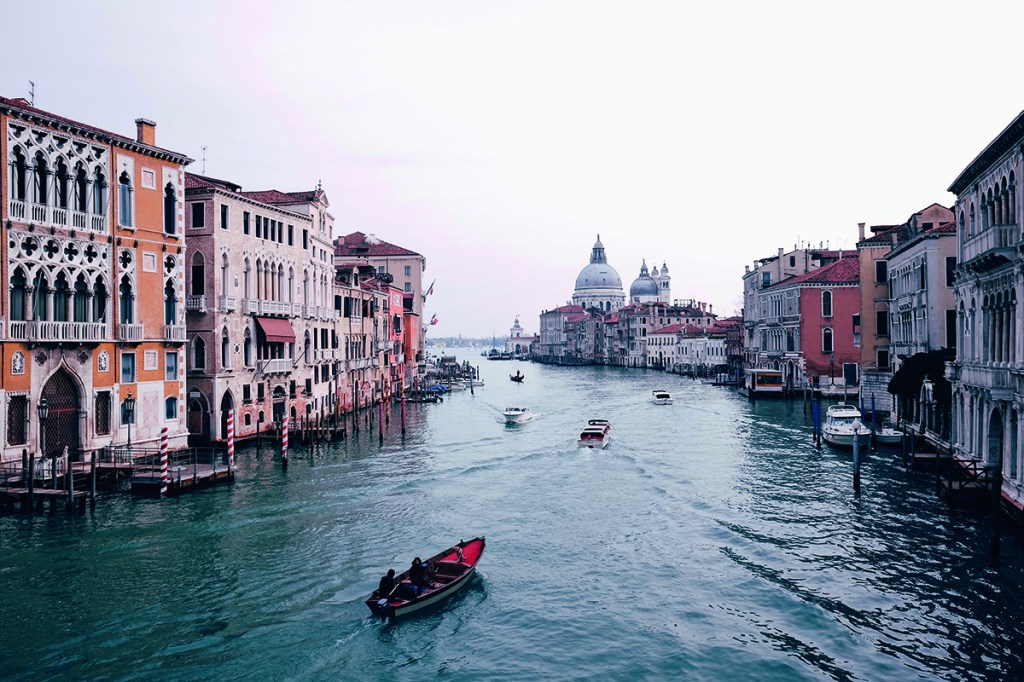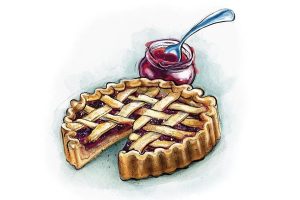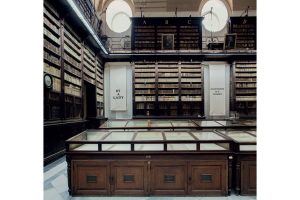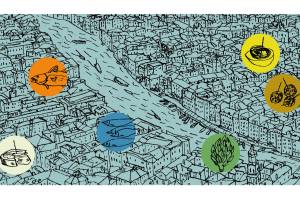A few years ago, I moved to Newlyn, a fishing village in west Cornwall. I didn’t understand why I moved to Newlyn until I returned to Venice. I take almost all my holidays in Venice, and it is a cliché that Venice only slowly reveals her mysteries. You must fight your way past a mass of Renaissance portraiture and mirrored palaces but the mystery it showed me this time is this: like Newlyn, Venice is a fishing village.
Venice got rich in the thirteenth century, monopolized the trade routes to the east for two centuries and covered itself in Istrian stone, which Newlyn didn’t. But it’s still a fishing village, founded by people running away from barbarians, into the mud flats of a lagoon to fish for crabs. It is easy to forget that — unless you look for Venetian cuisine. Most don’t. They come in on cruise ships or across the bridge by bus and walk from St. Mark’s Square to the Rialto and back and eat an ice cream and a ham and cheese sandwich. They don’t know what Venetian cuisine is. Bad food is normal in Venice, and this is bad. I am on the Zattere, Venice’s southern promenade, in a restaurant with alarming yellow seats floating on the Giudecca canal. The spaghetti aglio e olio (olive oil and garlic) is bad — the spaghetti is hard and grayish, the parsley is not fresh — and I knew it would be.
The quality of Venetian food is put down to justice — nothing is perfect without imperfection — and punishment too, because Venice is, among other things, the patient zero of over-tourism. Venice’s native population has halved since 1966, driven out by surging house prices, lack of opportunities beyond tourism and, on these sullen lagoon islands in a modern age, claustrophobia. It’s a bargain, and the Venetians are good at those. Marvel at the Tintorettos and eat the gray spaghetti. And we do.
I am not sure Venetian food is always bad. But in my experience, it always has been; or, if not bad, it never matched the glamour of its surroundings. Perhaps it was laziness, but I have eaten generic fine food at the Gritti Palace in a lightning storm and adequate to good fish at Al Gatto Nero on Burano and a marvellous white sugary cake at Harry’s Bar from a waiter who behaved like a very skilled psychiatric nurse, but nobody comes to Venice for the food. I am searching for good food in Venice. I am sure it is here.
We begin at the Osteria da Alberto, near the Miracoli church, which is miraculous in that it is pink marble. My landlady at the Casa Petrarca says the Osteria da Alberto is an authentic Venetian restaurant whose identity she only divulges to her favorite guests. It looks classically Venetian in the dour manner (the best manner). It has dark wooden furniture, a smashed-up marble floor (Venetian floors are ugly, made for flooding), and it serves some of the best Venetian food I have had. The olive oil with the (bad) bread is thin and needly. It serves fish — clams, sardines, octopus — hard, pungent cheeses from the Veneto (there are no cows on the lagoon nowadays, and the slaughterhouse has closed) and a dense, rich, damp salami, which makes the Italian salami we eat in England seem lifeless, as it is supposed to.
We eat veal liver and rich yellow polenta and pasta (but good pasta this time, made in this restaurant’s kitchen). It is a bar too, and the bar food is vegetables, which is why Italians are not fat. The photography on the walls is of old Venice. If I had once ruled a quarter and one-eighth of the Holy Roman Empire and now lived in a rotting, haunted Disneyland filled with people screaming for cheap ice cream and ham and cheese sandwiches and admiring without understanding its treasures, I would want to timetravel too. I would timetravel all the way across the bridge to Mestre on the mainland, and most have. At some point Venice became a dreamland for other people, and when that happens Venetians lose their own reality and flee.
There are many distinctions in Venetian restaurants. An important one is where Italians — but not Venetians — eat when they come to stay. They eat better than tourists. They demand it. So we go to Ten, on the Ponte del Teatro, which is part of an Italian restaurant chain. It is opposite the Grand Canal and the university district. There are many students in Venice studying at the Ca’ Foscari, the International University, the conservatoire and the academy of arts, and they eat at Ten. It is a bright, modern room above a supermarket, to put off the tourists who want a Grand Canal view and no supermarket. There is a supermarket on the Grand Canal, but it is by the car park by the bridge to the mainland. It sells the cheapest food in Venice.
Ten has the only proper pizza oven in Venice, a polished poison green metal dome, so of course we eat pizza under very restrained Murano chandeliers. Venetian glass is like Venetian food. Not all of it is horrible, but they keep the best for themselves — and why not? It is very good pizza, and it should be. But pizza is not a native Venetian dish, because there are no wheat fields in Venice, as there are no cows. There is, though, an agricultural island near the Lido called Sant’ Erasmo. It is famous for asparagus, artichokes, cauliflowers and salad, and no tourist ever goes there.
I meet Gioia Tiozzo, a local cook who teaches Venetian cuisine here and online, at the Rialto market, to shop for a lunch we will make together. I wait on the bridge and watch a boat filled with boxes of milk come in. I find anything ordinary about Venice mesmerizing. The Rialto was once the mercantile center of a great mercantile village, and this is its remnants. This is Venice hanging on by its fingertips to something as normal as food. The whole village would have shopped here once; now it is elderly locals, who don’t need much, and a few tourists staying in Airbnbs, who come because the guidebook told them to.
It is 8:30 a.m. and the market is quiet. It is, though, beautiful. Of course it is. The fish market is in a marble hall by the Grand Canal and its prices — long-ago prices, that is, possibly Renaissance prices — are carved in marble on the wall. You don’t get that in Newlyn, and when I told my friend the master fishmon- ger in Newlyn about the marble price list she gawped. From the fish market you can see the water through gauzy nets. The fish are spotlit and lie on slabs. They are brought from Chioggia, the nearby fishing port, or Burano, the island in the lagoon where the fishermen live and work. It is a truism that Italians are more handsome than other people. So are Italian fish. They glint with charisma, though dead. We buy cuttlefish from the lagoon and gilthead sea bream from Chioggia. They gut the fish for us on marble tables and throw the guts down marble holes.
We buy artichokes and bright pink lettuce from Sant’ Erasmo and walk to Gioia’s house near the Frari. As we go, she points out shops. There is the Casa del Parmigiano for cheese and cold meats and the Pasticceria Tonolo where I must go for fritole (doughnuts of all kinds: plain, with raisins, with cream, with cream and alcohol). She points out a greengrocer on a boat tied to a quayside. Her father, she says, had one just the same. She also shows me the native shops that have closed as the population leaves; most Venetian restaurants, she says, are not run or owned by Venetians anymore. They have been bought up by outsiders who serve bad food because it is cheaper, and they can.
Gioia’s home is immensely clean and dignified, as she is. It has a vast map of America in the hall, to welcome her guests. The table is already laid for lunch. Swiftly, in a spare white kitchen, she makes a tiramisù. She braises the cuttlefish and adds tomato passata, and makes a stock for the fish risotto. The risotto is superb; the tiramisù is the best I have had. And the cuttlefish from the lagoon? It is thick, tangy, filled with nutrients, and charismatic. It is also completely black.
Gioia sends me out with a list of restaurants — Ai Do Pozzi, La Zucca, Casa Cappellari— and bakers and ice-cream shops. On Sunday morning, I go to the Pasticceria Tonolo and find a queue of fifty Italians. That is my best advice for dining in Venice. If you find a queue of fifty Italians, join it. I buy sugared doughnuts filled with cream. I take them to St. Mark’s Square, and I am punished for it. I take one from the bag and take a bite. A seagull brushes gently into my head. He is phlegmatic and composed: a Venetian seagull. There is no need to attack me. A mere show of it will do. I drop it, and he eats my doughnut. It’s another tourist tax, and I do not resent it.
Gioia says the best restaurant in Venice is Osteria ai Do Pozzi in Castello, a residential district to the east of St. Mark’s Square. We find the restaurant, and it is entirely empty though, says the waiter, it is fully booked. Instead, we eat typical bad Venetian food, which is not Venetian food — the kind of chicken schnitzel you could use for murder — at an uncanny-themed restaurant with a vast painted mural of a witch for decoration.
We return to Osteria ai Do Pozzi the following night. The dining room is so understated I want to laugh at the irony and the rightness of it all: the walls and tables are mud brown. A waitress tells us what to eat. We eat, among Venetians and their babies, perfect mussels, a small and perfect lasagna, a bass from Chioggia with an eerie white polenta, then a wondrous, soft pistachio cake. We feel replete but alive, which is what a perfect meal will do, and we go to the Arsenale to look at the stone lions and wonder if a Venetian sculptor ever saw a lion.
I rise too late to meet the fishermen of Burano at their work. Still, I take the waterbus to this minute island of fishing and lacemaking. The houses are painted so brightly — in cerise pink, jade green, lemon yellow — they make the houses of Notting Hill look sullen. Jan Morris, who wrote the best book about Venice, said Burano looks like a stage set preparing to host a light opera. The harbor is likewise minute, as are the boats, stacked with gear for shellfishing. Everything here seems miniaturized.
We take the boat to Torcello, which was settled before the Rialto islands and became rich and was filled with palaces and churches. But no more: the canals silted up, the population was killed by malaria and the stones were loaded onto barges to build Venice itself. There is an extraordinary cathedral with a golden Madonna in mosaic, a field of olive trees, a vineyard and the Locanda Cipriani — the outpost of Harry’s Bar — which is closed.
Harry’s is named for a man who propped up a bar where the founder, Giuseppe Cipriani, worked, and who lent him money. It is the most famous restaurant in Venice. It sells branded spaghetti, cookies, tomato sauce and a book: a memorial to itself. It has spawned a family worldwide: five restaurants in New York City, two in Dubai, one in Abu Dhabi. In a village that looks excessive — everything is beautiful, everything is mirrored — Harry’s Bar looks like a ship’s bar, or a workingmen’s club, like one I recently found in Batley in Yorkshire. It wasn’t a Cipriani restaurant, but in Venice it could be. Its magic is in its understatement. Anywhere else it would be normal. Here, where the frontage is literal, it feels subversive, and that is why the most pretentious tourists go there.
Locanda Cipriani is a bright white block which used to be a cordage warehouse. It is small and Cipriani decided to miniaturize everything: as in Burano, space is at a premium. It is all brown woods. I didn’t mean to visit the Locanda, which is as much myth as place, but I find myself outside it in sunshine, and it is empty apart from the staff, so I go in for coffee.
I cannot leave without going to Caffè Florian in St. Mark’s Square. When I was seventeen, on my first visit to Venice, I went straight to Florian and drank hot chocolate. Florian is the ultimate Venice tourist joint: it looks after you, it fleeces you and it kisses you farewell. It is older than its rival grand café, Quadri, which was beloved by the Austrian occupiers who came after Napoleon took the village without a fight and ended the Venetian republic, while Florian stayed loyal to itself.
Florian looks like a cake. It has no choice. The interiors — mirrors, paintings, frescoes, red velvet seats and tiny marble tables that swing to accommodate large parties — are protected historic properties and, after the acqua alta (“high water”) floods Florian, they must be replaced as they were in 1858. The boundary, the deputy manageress tells me, is simple — they close when the water threatens to come inside. I have drunk coffee outside Florian in a flood: tourists like it, though it is mad. They put trash bags on their legs — or waders if they are organized, but they never are — and the waiters walk on duckboards jauntily: look, water!
They can feed three hundred people at a time, she says. The food comes by boat to the Giudecca canal and is carried from the boat stop by hand. When she bangs on the kitchen wall so I can meet Chef Stefan, I see that the kitchen, like the boats and Harry’s and the houses of Burano, is minute. This is possible because Florian isn’t a restaurant, not really: it serves sandwiches and cold meats and pastries and, if pushed, an omelette. It is not dining, but theater. Even so, Florian is keen to attract native Venetians. They offer them 30 percent off coffee and spritzers a few days a month. It won’t stop the death of Venice as an Italian village, but it is a pleasing nicety.
I found good food in Venice. But I can’t stop thinking about the cuttlefish and its meaning. On the ground floor of each medieval Venetian palace was a warehouse, and that was the foundation of all their wealth. The food, I think, never left the ground floor. They built an empire from a fishing village and made the most beautiful palaces in history. They still love black food pulled from the lagoon that saved them, and, of all the things I admire about them, I admire that the most.
For information about Gioia Tiozzo’s cookery school, see: accademiadicucinaitaliana.com. This article was originally published in The Spectator’s April 2022 World edition.


















